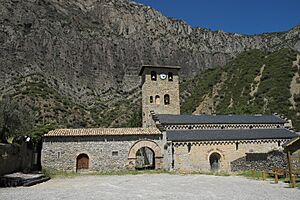Abbey of Santa María de Alaón facts for kids
The Royal Abbey of Santa María de Alaón is an old monastery in Sopeira, a town in the Pyrenees mountains of Aragon, Spain. It was built a long time ago, possibly in the 6th or 7th century, and then rebuilt around the late 1000s or early 1100s. This abbey is famous for its special building style called Romanesque, which was popular in Europe many centuries ago.
Contents
A Look at the Abbey's History
How the Abbey Changed Over Time
For many centuries, monks lived and worked at the Abbey of Santa María de Alaón. But in 1836, the monastery was closed down by the government. It then became a regular church for the town of Sopeira.
About 100 years later, during the Spanish Civil War, a fire damaged some parts of the abbey buildings. Luckily, the church and other surviving structures have been repaired. Today, the church is still used by the local community.
Exploring the Abbey's Design
What the Church Looks Like
The main church building is shaped like a basilica. It has three long sections inside and rounded ends called apses. There is also a tall, square bell tower with four levels.
The main entrance has a special archway with a pointed top. Above the doorway, you can see a symbol called a chrismon. This symbol represents the Trinity. The monastery used to have a cloister, which is an open courtyard with covered walkways. Now, only the bases of a few columns from the cloister remain.
Discovering the Ancient Crypt
Secrets Beneath the Church
Underneath the main part of the church, two stairways lead down to a hidden crypt. Recent studies have shown that this crypt was once a small temple built by the Visigoths. The Visigoths were an ancient people who lived in Spain many centuries ago.
When workers removed some modern plaster from the crypt's ceiling, they found old writings. One set of words dedicated the church to Saints Peter and Paul. Another set, written in red Visigothic letters, dedicated the small temple to Saints Nereus and Achilleus.
The Abbey's Important Records
What is a Cartulary?
The abbey has a very important collection of old documents called a cartulary. Think of it like a very old record book. This book contains many papers about the abbey's founding, its special rights, and its church rules.
The cartulary also includes information about family histories and events from the Middle Ages, covering the years 806 to 1245. Experts believe this record book was put together in the late 1100s. Some later documents from the 1200s were added too. Around the 1400s, someone, probably a monk, added more notes about events in the County of Ribagorza during the 1000s and 1100s.
A Count Buried at the Abbey
The abbey's cartulary also tells us that Bernard Unifred, who was a Count of Ribagorza, and his wife are buried there. Recently, during archaeological digs, a tombstone was found on the northern wall of the church. It honors Count Unifred with the words "Venerabilis Unifredus Comes," meaning "Venerable Count Unifred."
See also
 In Spanish: Monasterio de Santa María de Alaón para niños
In Spanish: Monasterio de Santa María de Alaón para niños


